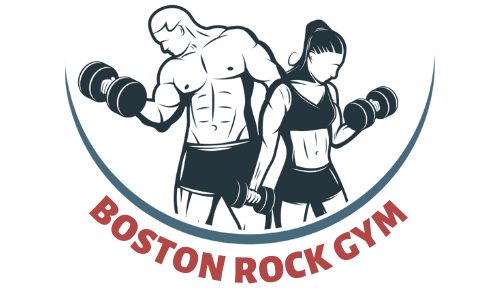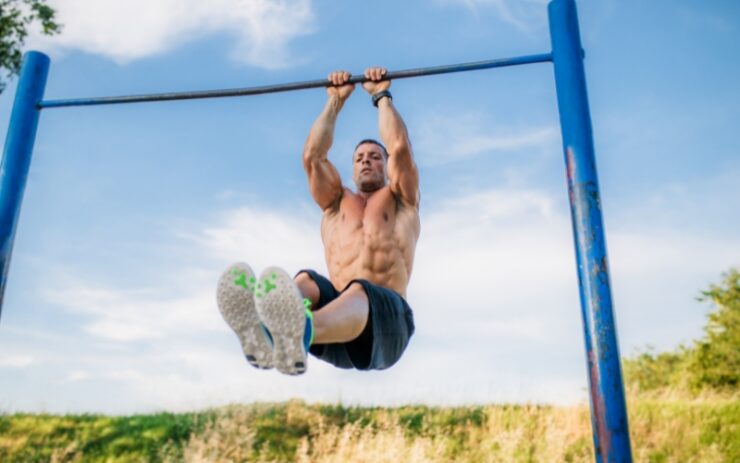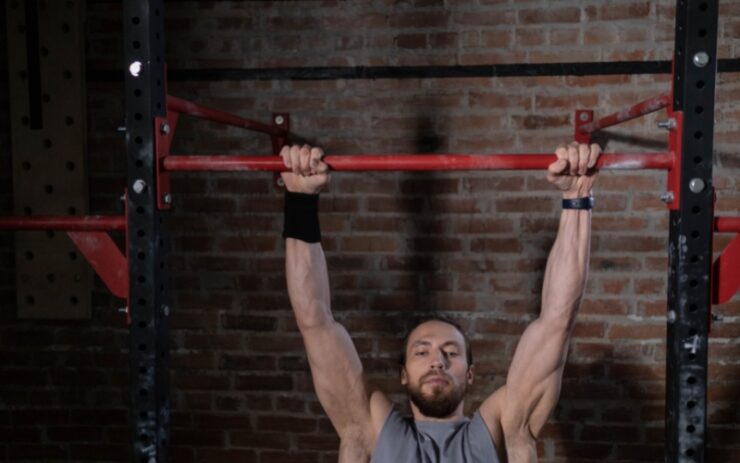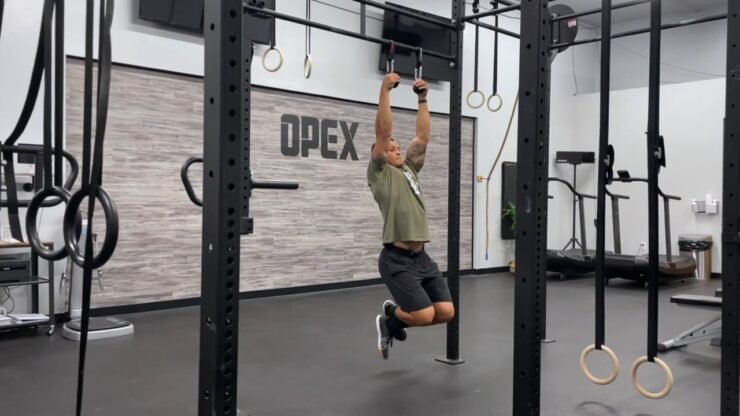One of the toughest exercises for the upper body is the pull-up. There’s a reason it’s employed in a lot of physical performance tests, including those used by the army and in a lot of sports.
Although the pull-up grip will be standardized in most trials, is there an ideal pull-up grip you should employ during your training? The answer is yes, you can and should find a perfect pull-up grip that will work in your workout routine.
The key is to find the grip that will fit your needs perfectly but to do that, you have to know what grips exist, to begin with.
Not to worry, though, because we’re here to provide you with the top 9 pull-up grips for back and biceps to choose from! You’ll be able to start incorporating your favorite ones into your routine in a jiffy!
Contents
Top 9 Best Pull-Up Grips for Back and Biceps
1. Standard Pull-Up
This conventional pull-up grip is one of the best workouts for the back and biceps, and for a good reason. It’s a strenuous upper and midback builder that focuses primarily on your lats and traps while demanding that you touch every muscle group as long as your chin is above the bar.
This pull-up is a tried-and-true exercise for building strength and size that is used worldwide to measure general physical strength and fitness, including in many militaries. Even though the biceps are included in the workout, the back muscles still have the upper hand.
2. Wide-Grip Pull-Up
The wide-grip pull-up adds even more difficulty. It absolutely eliminates the role of your pectoral muscles. The outcome? All of the labor is mostly being done by your back. With this one, you’ll definitely feel the burn.
Make sure your hands are broader than your shoulders while performing a wide-grip pull-up. Avoid going too far, but make sure the distance is sufficient to make a difference. Pull hard as if your life relies on it other than that.
3. Close Grip Pull-Up
In both name and the muscles required to complete it, the close-grip pull-up is completely contrary to the wide-grip kind. As a result, it’s a fantastic method to create a pull-up-specific exercise, ensure that you’re getting the most out of it, and determine which variation is the greatest match for what you need it to achieve.
Other than the reverse close-grip pull-up or chin-up, the close grip involves the biceps more than any other variation and makes them the primary target. As long as your arms are strong enough, this also makes it possible for the pecs to contribute more to the workout than they have in any previous version.
It is possible to get a little bit deeper into a one-handed or assisted one-handed pull-up hold, but this is frequently unstable and dangerous. Make sure you’re being extra careful when you do this.
4. Neutral Grip Pull-Up
Pull-ups performed in a neutral position significantly alter the exercise’s mechanics. This variant uses bars that branch off of the main bar to provide a sideways grip rather than shifting the hand locations along the bar as the other versions do, similar to what is seen in exercises like the hammer curl. That’s fantastic for harder, more varied muscle contact.
Other benefits and drawbacks of neutral grip pull-ups exist as well. Since the movement style is freer than it is with other grips, it’s a terrific technique to reduce the danger of injury (ideal if you’re inexperienced in doing pull-ups). The drawback is that it doesn’t strike the back as hard.
5. Chin-Up Pull-Up
Because it is the least comparable to other pull-up exercises, the chin-up is perhaps the friendliest variation. Your biceps will be performing the majority of the work thanks to the inverted grip, which radically alters the game. They are quite similar to the neutral grip, but because of the increased emphasis, you probably weren’t aware you weren’t getting the full benefits of your arm exercise.
Your hands must be towards you in order to perform a chin-up. After that, proceed with the exercise precisely as you would any other pull-up. Until you reach the peak of the lift, squeeze your arms. This exercise is considered one of the greatest bicep workouts available, even better than curls.
6. Mixed Grip Pull-Up
This could be the exercise for you if you enjoy pull-ups but are unsure of how to approach them. The greatest thing you can do for your advancement is to complete them all, but if time is of the essence, this is a speedy solution.
Give each hand a normal grip and a reverse grip. It all boils down to that. It works on a variety of muscles and helps you accomplish your goals quickly. But remember that you should switch and distribute your work fairly. Imbalance is not your friend.
7. Muscle Up Pull-Up
Pull-up grips are pushed to their limit in muscle-ups. They are really challenging, but as far as workouts for the upper body go, they are arguably the greatest. Unfortunately, even without the use of weights, most of us would find it difficult to complete them.
When you reach the apex of the exercise, you must then push yourself up utilizing your chest and triceps until your arms are completely extended. The method is precisely the same as a pull-up. You have only completed a full rep when you have completed everything.
8. Towel Grip Pull-Up
As the name implies, a towel grip pull-up requires draping a towel over a pull-up bar and pulling yourself up while holding onto the two ends of the towel. Towel pull-ups focus your forearms, grip, and hand strength, which may convert into grip strength for other actions like rope climbs while also demanding your other pulling muscles.
Focus on maintaining the ribs and chin down to maintain a hollow body position throughout the towel pull-up exercise since it’s easy to allow the spine to expand.
9. Grenade Grip Pull-Up
When performing grenade grip pull-ups, you hang fist-sized grenade balls over the pull-up bar and pull yourself up while clinging to them. Grenade ball pull-ups are particularly useful for developing grip and hand strength, as well as forearm strength, even though they still call for significant amounts of lat and bicep muscle.
Grenade grips can occasionally be helpful for lowering or eliminating joint discomfort during pull-ups for people who experience wrist or elbow problems.
Your biceps, as well as the rest of your upper body, can benefit from a superior workout from any pull-up variation if you concentrate on slow, controlled movements the whole time. Once you’ve mastered each variation, you may make the pull-up more difficult by adding weight to it. You can do this by wearing a weight belt or by holding a weight plate between your ankles.
To prevent your biceps as well as other muscles from adapting to a certain variety, incorporate a range of pull-ups into your routine. Vary your grip width, but don’t grasp the bar wider than the shoulders width apart. Before training your biceps again, let them rest for at least a day to encourage healthy muscular growth.
Pull-Up Benefits
The pull-ups should be a crucial component of your back and bicep regimen if you’re interested in using the pull-up for weight reduction and fitness. Compound action bodyweight workouts like push-ups, pull-ups, and chin-ups help your body become a calorie-burning inferno.
Bodyweight exercises for the upper body use more synergist muscles than separate movements you could perform in the gym. More muscles used results in more calorie burn. Your metabolism benefits from these types of exercise.
Our bodies are remarkable at adjusting. Because of this, it’s crucial to continuously vary your training routine to avoid plateauing if you want to keep getting stronger. For their back exercises, most people just alternate between chin-ups and pull-ups. The neutral grip, on the other hand, adds a third option to the mix, expanding your choice of pulling exercises by 50%.
Although pull-ups are typically thought of as a back workout, they are also great biceps exercises. Some claim that pull-ups are primarily an arm workout and only secondarily a back exercise since the bicep is a smaller, weaker muscle than the lats. Pull-ups might be beneficial if you desire stronger arms in either case.
Conclusion
To keep your shoulders and arms healthy, switch up your grips as much as you can. Choose the grip that will more effectively target the muscle you want to strengthen if you want to grow a weak area of your body. Remember to consult your doctor or other health care provider before starting any workout or diet regimen.
People over 35 or those with pre-existing medical conditions should pay particular attention to this. Other than that, keep in mind that consistency is key, so keep up the good work and you’ll start seeing the results in no time!







